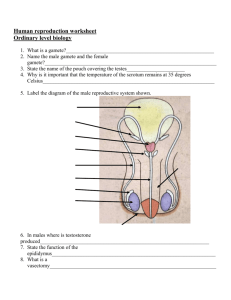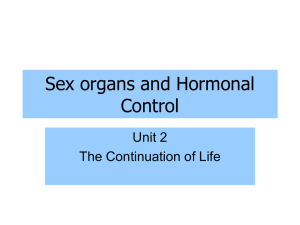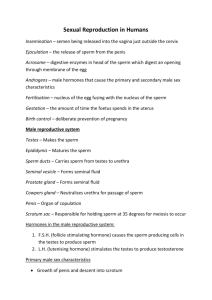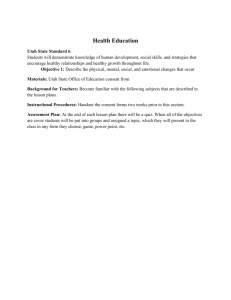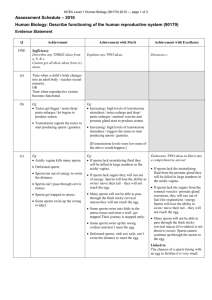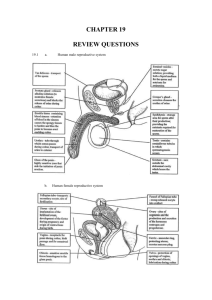Development of Placenta
advertisement
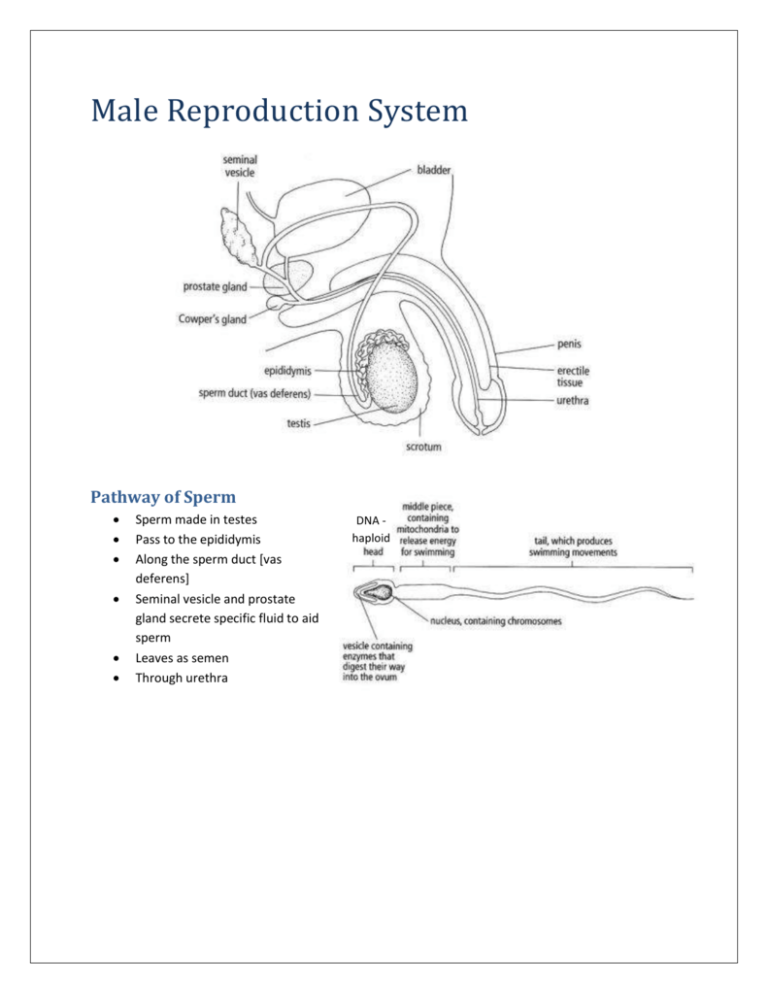
Male Reproduction System Pathway of Sperm Sperm made in testes Pass to the epididymis Along the sperm duct [vas deferens] Seminal vesicle and prostate gland secrete specific fluid to aid sperm Leaves as semen Through urethra DNA haploid Formation of sperm [Spermatogenesis] Stimulated by two hormones: o Follicle-stimulating hormone [FSH] released from pituitary gland o Testosterone released from testes Sperm is produced in the testis Cells divide by mitosis to produce 2 diploid [2n] primary spermatocytes These primary spermatocytes then divide by meiosis to produce 4 haploid [n] secondary spermatocytes These then divide to produce 4 haploid spermatids[immature sperm cells] In the Lumen: Seminiferous tubule Spermatids attach to nutritive Sertoli cells [protects sperm from toxins in the blood and provide food] Here they develop in to mature sperm cells Sperm cells are then stored in epididymis Female Reproduction System vulva Ovaries produce the ova The ovum travels down the oviduct[fallopian tube] to the uterus [muscle organ richly supplied with blood vessels] Ovum Much larger than sperm Does not move on its own Needs greater energy reserves [such as lipids for zygote development] Formations of a Ovum Primary oocyte By mitosis, the follicle develops into diploid primary oocytes when the female is born The primary oocytes divide by meiosis to form haploid secondary oocytes The secondary oocyte, a mature follicle, is called Graafian follicle Menstrual Cycle Hormones Oestrogen – stimulates repair and growth of uterus lining. It is always secreted from Graafian follicle before the ovum is released into the oviduct. Estradiol – made by Graafian follicle - high levels stimulate anterior pituitary gland to secrete LH [Luteinizing Hormone], which cause the follicle to release an ovum into fallopian tube Progesterone – maintains the uterus lining as a thick, spongy layer. When an ovum is fertilized, the corpus luteum continues to secrete progesterone [and little oestrogen] and stops when the placenta secretes progesterone When an ovum is not fertilized, the corpus luteum breaks down, the level of progesterone falls and the lining of the uterus breaks down. Secondary Sexual characteristic Pituitary gland produces hormones [FSH – the primary preparatory hormone of ‘reproduction’] which stimulate the ovaries to produce oestrogen and progesterone; and the testes to produce testosterone. Characteristics of: Testosterone in a male Oestrogen in female More fat is deposited in body Pelvis widens Hair grows on armpits Pubic hair grows Growth spurt Sex organ develops in size Testes produce sperm Ovaries and menstruation occurs Sexual maturity is reached at puberty. The period during the approach to puberty is adolescence. Vocal cords elongate and voice breaks Body muscle grows Hair grows on face, chest and armpits Pubic hair grows Male sex organ increases in size Fertilization Ejaculation [caused by contraction of muscle tissue in the sperm ducts, seminal vesicles, and prostate glands] of semen is expelled and deposited near cervix The ovum has a membrane that prevents more sperm getting in once one sperm has already penetrated it. The mechanism ensures: Zygote [fertilized egg] becomes a diploid zygote Enables the zygote to divide by mitosis to form a an embryo [ a ball of cells] Implantation The embryo is wafted by ciliated cells lining of the oviduct to the uterus, where the embryo sinks into the soft lining of the uterus. Development of Placenta Placenta is formed when the outer layer of cells of the embryo produces finger-like projections called villi. These villi penetrate into the blood spaces of the uterus lining. Small blood vessels develop inside the villi. The part of the lining next to the embryo thickens and this maternal part becomes the placenta. The embryo then develops into a fetus [called that when limbs and eyes are recognizable] Functions of Placenta Act as an endocrine gland to produce hormones [oestrogen and progesterone] Exchange of substances while keeping blood separate: Diffusion into placenta Oxygen Lipids Amino acids Glucose Antibodies [passive immunity] Diffusion out of placenta Urea Carbon dioxide Amnion After implantation, a group of cells in the embryo develops into the amniotic sac – contains amniotic fluid [acts as a cushion to reduce mechanical shock; prevents pressure; has large heat capacity which helps to minimize temperature changes] Ante-natal care Period of gestation [growth] before the birth of the baby, as the woman gains more weight and extra fat stores thus making her heart beat faster. Therefore she needs: Calcium and iron More exercise More food Effects of narcotics, smoke and alcohol on Fetus In the fetus: Carbon monoxide prevents haemoglobin from carrying oxygen Reduces baby’s size More susceptible respiratory infections Alcohol Fetal alcohol syndrome – brain under developed, intelligence is depressed and growth is delayed/stunted Narcotics Born addicted Physical and mentally handicapped Advantages of Breast milk Correct temperature Free from harmful microorganisms Passive immunity [antibiotics] Convenient Free Birth Control and Fertility Methods NATURAL Rhythm method [monitor menstrual cycle, have intercourse before ovulation] Abstinence CHEMICAL Contraceptive pill [contains progesterone which prevents ovulation; can increase myocardial infarction, nausea, weight gain, depression and tiredness] Morning-after pill [oestrogen prevents ovulation, progesterone prevents fertilization and implantation] Spermicidal cream [kill sperm] Condom Cap [diaphragm – dome shaped cap that fits around cervix] IUD [intra-uterine device – piece of metal with projections which fits in uterus; prevents implantation] Sterilization [Irreversible] o Vasectomy – vas deferens is cut o Hysterectomy – ovaries remove/uterus remove/fallopian tubes cut MECHANICAL SURGICAL Artificial Insemination Abundance of collected semen from a donor is inserted into the vagina Fertility Drugs FSH/Hormones is given to the women to stimulate ovulation and oestrogen secretion However, this method can cause multiple ovulations and births [generally the babies die in this case] ‘Test-Tube’ Fertilization This is when sperm is added to ova, in a dish with the same consistency [pH, Temp., nutrients] as the uterus outside the woman’s body, performed when oviducts are blocked. Then three ova are returned into the woman’s uterus. Other uses: Too produce pure-bred beef bulls...as generally the bulls would mate with the milk producing cow and thus create a mix-breed. Sexual Transmitted Diseases Lead to infertility and death Gonorrhea Caused by bacterium and reside in the lining of male and female reproductive organs. Can be treated with ANTIBIOTICS. In men: Sore on penis, discharge of thick yellowish fluid; a burning sensation when urinating Sperm ducts become block – lead to infertility In women: Thick, smelly discharge, burning sensation when urinating oviducts become block – lead to infertility Syphilis Caused by bacterium and reside in ulcers around male and female reproductive organs. Can be treated with ANTIBIOTICS. After a few months, sores and ulcers form on other parts of body; skin rash and fever symptoms arise. After a decade, the bacterium has damaged bones, blood vessels, the liver and nervous system. Consequently leads to serious brain damage, insanity and finally death. HIV The virus enters the body by sexual fluids and blood. Slowly breaks down immune system and this HIV positive organism may develop a disease called AIDS – which they may die from relatively minor infections such as pneumonia, TB, etc. Prevention Test sexual partners Have one partner Use a condom during intercourse Use sterilized needle and gloves when dealing with blood Educating people bout risks and consequences – encourage safe sex
